More information about this website & why it was created can be found by visiting this website's "front" pages (link opens in a new window)
A series of pages which look at different types of passenger trains
as defined by the type of service they are designed to provide.
Long Distance InterCity Trains looks at trains which are designed for InterCity express journeys with journey times usually in excess of 45 minutes and possibly lasting for many hours.
Medium Distance Trains looks at different types of trains that provide medium distance services, typically with journey times of between 30 and 90 minutes in duration, but sometimes longer too.
Short Distance Trains looks at trains designed for journeys of anything from less than a minute up to about 45 minutes within urban areas and their close hinterland. These trains could be operated by either a mainline railway company or a city-specific regional transport authority. Included within this remit are Automated 'Driverless' Metro Systems and Trams, Streetcars and Light Rail Vehicles; however to avoid making a very large page the latter two topics have their own dedicated pages.
"Walk-through" Trains looks at the need to be able to walk from carriage to carriage along an entire train's length, this being an aspect of train design where practical day-to-day passenger requirements are often compromised.
On-train Refreshment Facilities, Double-Deck Trains, & Taking Bicycles On Trains looks at three specific aspects of railway operation which transcends all the other categories as described above.
Page Index.
On-train Refreshment FacilitiesFor all but the shortest of journeys many railways provide their passengers with on-board refreshment facilities. In theory the refreshments available will vary depending on the type and duration of the journey the train is undertaking; this section looks at some of the options. Traditionally InterCity trains on busy trunk routes would offer a full restaurant service using passenger coaches dedicated to the diners. Sometimes there would even be several dining cars (often one each for first and third class passengers)
plus a kitchen car too. Restaurant services such as this are labour intensive - often requiring two chefs and at least two or three servers - so can be expensive to operate. They are also the most difficult form of refreshment facility
to manage as passengers tend to arrive en masse (at stations) and all want their exquisitely prepared meals 'asap' so that they can enjoy maximum eating time before the train arrives at their destination station. This puts the on-train chef's
under immense pressure to work very fast in a cramped and swaying kitchen section. The limited space also restricts the menu options which can be unfortunate if the choice of what is available is unsuitable for some people's dietary requirements
(eg. vegetarians). On secondary routes food, if served on the trains, would be purchased from a buffet coach which would also include seated (and perhaps standing) areas for passengers to consume their purchases. Nowadays it is rare for there to be more than one restaurant coach on a train, and usually it will be next to the first class seating area - or even included as part of the first class seating area. This is because providing refreshment facilities is not just expensive in terms of staff costs but the dedicated eating area can also reduce the overall passenger capacity (and hence perceived potential profitability) of the train. Unfortunately many of our InterCity railcos treat standard class passengers as "second class" and only allow then to use the restaurant if the first class passengers have not completely filled it. Often restaurant services are only available Monday-Friday daytimes - ie: not late evenings, at weekends or on public holidays. Since privatisation some railcos (especially some of the longer distance railcos) have made significant investments in the range and quality of the foods their restaurants offer to passengers, with some of them winning cordon bleu awards for their fare. Meanwhile, some other railcos (even longer distance railcos) have effectively downgraded their refreshment facilities to mirror the facilities as offered by the "full service" airlines. Usually this includes completely abolishing the restaurant coach and serving (first class) passengers at their seats. Many railcos also offer first class passengers complimentary newspapers and light refreshments, which during the week will usually be served at their seats by a steward, although at weekends and on public holidays the passengers may have to collect these from the buffet. Meanwhile standard class passengers can buy food from the buffet or refreshment trolley, whichever is available. Or they can consume their own food, for instance bought at the station before joining the train. Most modern trains provide every passenger a table (fixed or airline-style fold-down) for this purpose (except on trains designed for very short journeys). |
|||||||
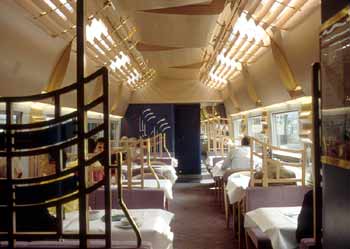 |
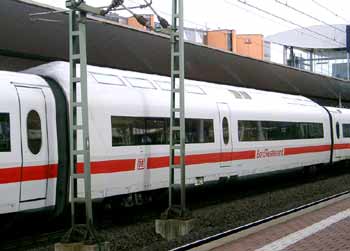 |
||||||
| Restaurant area with tables set out for dinner on a German ICE train. Note the first class style 2+1 seating. On these trains the restaurant coaches feature raised roofs with skylights, giving them a distinctive interior ambiance. The raised section is 45cms (about 18in) higher than the rest of the train, this was necessary to fit all the kitchen equipment. | |||||||
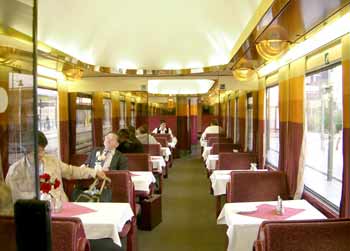 |
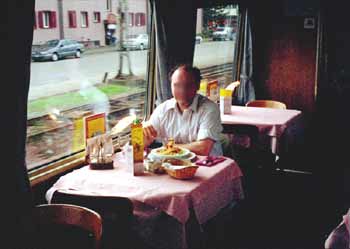 |
||||||
| Passengers in this Hungarian restaurant carriage dine in palatial surroundings under twin domed ceilings designed to create the ambiance of the opulence of the former Ottoman empire. | A portrait of yours truly as taken by a restaurant steward on a Swiss train as we passed through Muttenz, whilst approaching Basle. | ||||||
I would have been eating something simple but delicious - such as (hopefully wholegrain) pasta
with herbs & tomato sauce (all hopefully G.M.O. free) and drinking still mineral water (without ice). No meat, no alcohol, (just dont need) and no "pop" soda drinks which usually contain either an overdose of sugar or harmful artificial sweeteners.
As speeds increase and journey times shorten so there is an increased likelihood of arriving at a person's chosen destination before having had enough time to eat a meal - and pay for it! Especially when (as with any quality restaurant) the time taken for the chef to personally prepare the fresh food and cook the meal is also taken into account. The airline industry has also experienced these issues, plus has found that because of the very limited space on the aircraft the preparation of meals for every passenger can be physically "very challenging". The "full service" airlines deal with these issues by serving their passengers complimentary 'tray' meals which are prepared in advance (at a central catering facility off the aircraft) with hot foods being rapidly reheated / warmed up (often in a microwave oven) before serving. Meanwhile on all but the shortest flights the "budget" airlines usually sell light refreshments from trolleys which the crew wheel along the galley. Some rail services now emulate the airlines by offering their first class passengers airline style at-seat complimentary drinks and 'tray' meals which are also prepared in advance at a central catering facility, and (some of them) even offer the option whereby passengers who require special meals (eg: vegetarian, ceoliac, gluten-free, etc.,) can pre-book them in advance of travelling. (Sometimes breakfast also includes some non-tray items too, such as breads and croissants, as seen below - right). |
|||||||
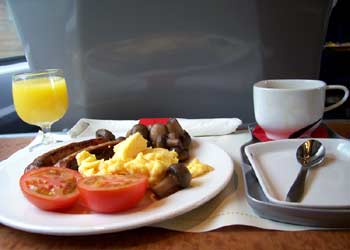 |
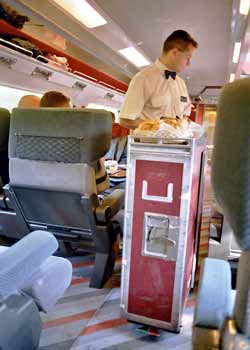 |
||||||
| The full English breakfast on a Virgin trains. Image courtesy of Peter Skuce. |
Breakfast is served on a Channel Tunnel London - France / Belgium "Eurostar" train. Despite being a railway service Eurostar behaves more like an airline - especially with its requirement that passengers 'check-in' in advance of travel and airline-style ticketing regime. | ||||||
As with the budget airlines, standard class passengers must buy their refreshments - either from the buffet carriage or from the refreshment trolley, depending on which exist on that service. But then they (usually) paid less for their travel ticket - so the reality is that the so called "complimentary" food which first class passengers receive could more aptly be described as "included in the cost of the travel ticket". (There is no such thing as a "free lunch", as the saying goes). |
|||||||
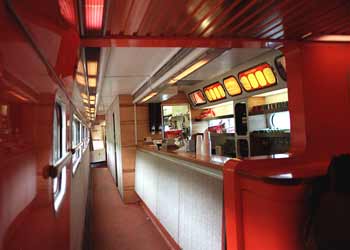 |
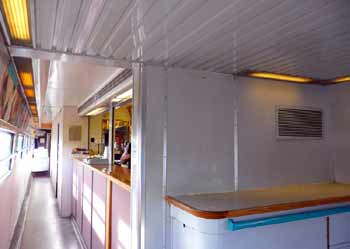 |
||||||
| The buffet counter on an InterCity 125 High Speed Train, showing the original 1970's decor. To my right is a 'counter' type eating area whilst further down the carriage is the kitchen and (beyond) a table seating area for all passengers buying food. | A comparative view from 2009. The splitting of the railway system in to many different business units means that the trains on other routes will have been refurbished slightly differently. |
||||||
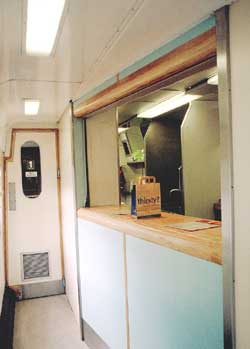 |
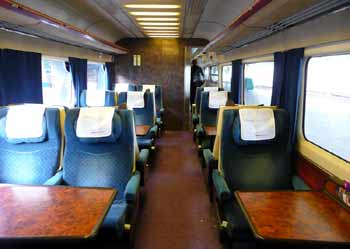 |
||||||
| More recently the trend has been to include the seated eating area as part of the first class passenger space, dispense with the stand-up eating area and provide a small 'micro' buffet counter. Note the door keeping standard class passengers away from the former seating area and the paper bag containing my hot cappuccino... for carrying back to my seat. | The former 2nd class eating area in a buffet carriage after conversion to become part of the 1st class seating area. Typically on weekdays 1st class passengers are served food at their seats, however at weekends they may still need to walk through the train to the buffet counter. | ||||||
In Britain safety regulations stipulate that all 'take away' hot drinks must be supplied in carry-bags. This is to prevent passengers from burning their hands (on the plastic cups) when returning to their seats and also to reduce the incidents of passengers who loose their balance on the swaying train from accidentally spilling their very hot drinks onto seated passengers. |
|||||||
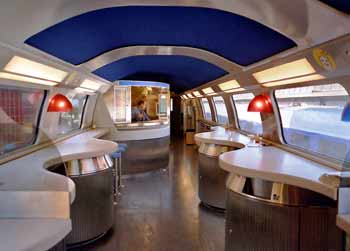 |
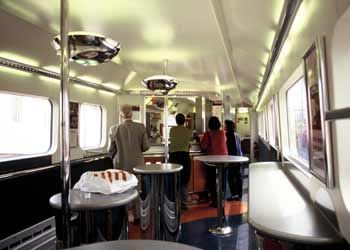 |
||||||
| On the double-deck TGV Duplex trains the buffet is upstairs. The scalloping of the counter increases counter space and space for passengers walking through the often crowded carriage. Note the lack of seats - passengers are expected to stand whilst eating. These trains are mostly used on the Paris - Lyon route where with a journey time of just two hours there is not enough time for a full meals service. | The "stand-up counter" philosophy also applies on the (single deck) TGV-derived Eurostar trains. This view is from one of the "North of London" trains which was meant to link Northern England (and Scotland?) with Europe and for a while was used as part of the GNER franchise out of London Kings Cross station. | ||||||
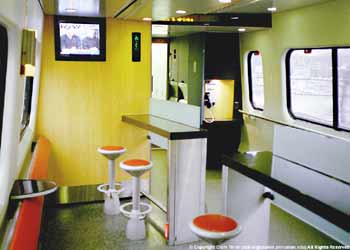 |
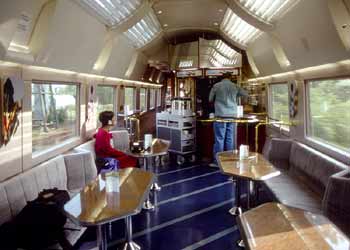 |
||||||
| The inside of the American Acela Express bistro car, showing TV news, a telephone, bar stools, etc. The windows of the bistro car are set higher than in the other cars, to provide good views while standing. Image courtesy of Clem Tillier. |
Buffet / lounge carriage on a German ICE train, this example is designed more for light snacks than meals. |
||||||
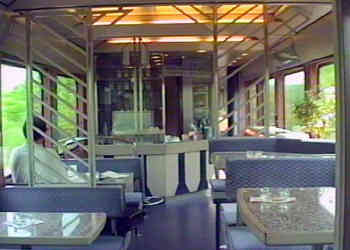 |
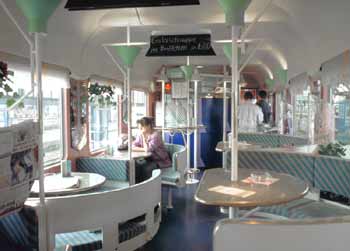 |
||||||
| Variations on a theme; some more internal designs for buffet / restaurant eating areas on European trains. | |||||||
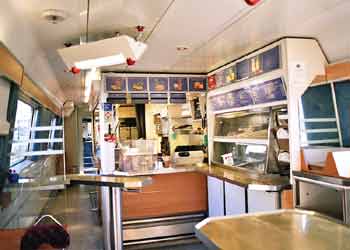 |
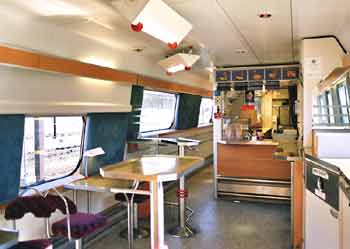 |
||||||
| The Swedish XP2000 tilting trains have cafeteria-type buffet areas where passengers carry their purchases on trays and select (hot) food from
the self-service servery - as seen on the trains' far wall in the image above left. The image above right also shows that the tables are arranged at different levels to suit both seated and standing passengers. As with most of the images, clicking them opens a larger version in new windows |
|||||||
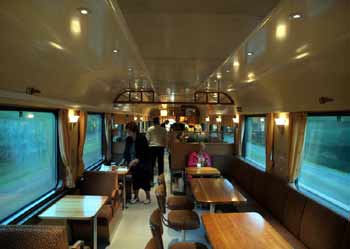
Image & license: JIP / Wikipedia encyclopædia. CC BY-SA 3.0 http://commons.wikimedia.org/wiki/File:Dining_car_aboard_a_Finnish_train.jpg |
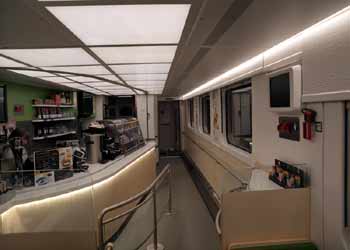
Image & license: JIP / Wikipedia encyclopædia. CC BY-SA 3.0 http://commons.wikimedia.org/wiki/File :Dining_car_aboard_a_Finnish_InterCity2_train_almost_empty.jpg |
||||||
| Convivial buffet / dining car interiors on trains in Finland. To create space for passengers walking through the buffet carriage the food servery counter is less wide near the barrier which separates passengers queuing to pay for their food from passengers walking through the train. | |||||||
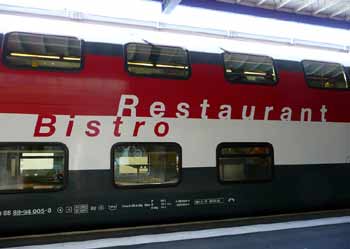 |
 |
||||||
| On the IC2000 Swiss double deck trains the restaurant is upstairs - with a "dumb water" lift linking it to the kitchen which is on the lower deck. The steps which lead up to the restaurant include an illuminated sign pointing towards it (above right). The buffet / bistro is downstairs. | |||||||
|
|||||||
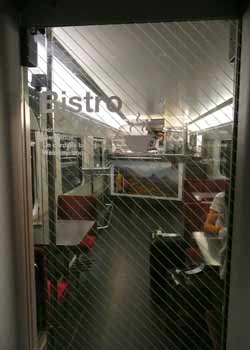 |
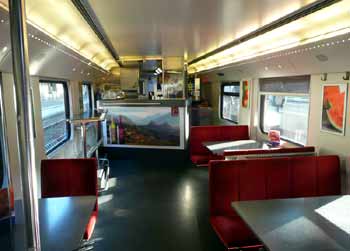 |
||||||
| The lower deck bistro. Unusually the counter is virtually the full width of the carriage - this is because on these trains the lower deck is not configured for passengers to walk through from carriage
to carriage. Also note how the roofline is flat to follow there being a floor above it.
Double-deck trains are looked at in greater detail in the section below. |
|||||||
A Few Examples From JapanThe first example comes from one of the very high speed Shinkansen trains. This is seen on the right. The other examples (below) show the Shimakaze train which is operated by the Kintetsu railway, this being one of the Japanese private railways. This train is used on a scenic route where the journey justifies sightseeing style trains. |
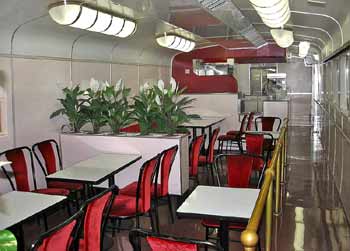
Inside a buffet car on a Shinkansen O series train which dates from the 1960s. Not easily seen are the windows on this side of the carriage. Image & license: Wikipedia encyclopædia. CC0 (public domain) http://commons.wikimedia.org/wiki/File:Shinkansen_sereis.0_WEST-Hikari%27s_buffet02.JPG |
||||||
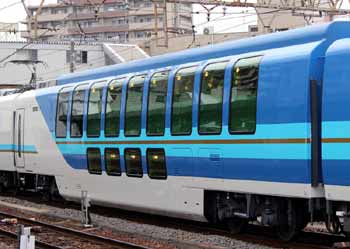 |
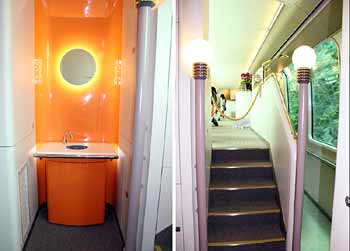 |
||||||
| A Shimakaze cafeteria carriage - these feature an unusual interior design with sideways facing seats along just the one side of the train.
Image & license: Oka21000 / Wikipedia encyclopædia. CC BY-SA 3.0 http://commons.wikimedia.org/wiki/File:KINTETSU50000_SA50400.JPG |
A composite view: the left side shows the hand wash facility; the right side shows one of the stairways to the upper level plus the passageway which can be used to reach the
far end of the carriage without brushing past the backs of seated cafeteria passengers.
Image & license: Oka21000 / Wikipedia encyclopædia. CC BY-SA 3.0 http://commons.wikimedia.org/wiki/File:KINTETSU50000_CAFETERIA1.JPG |
||||||
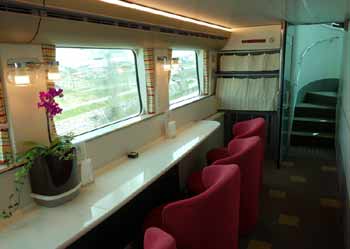 |
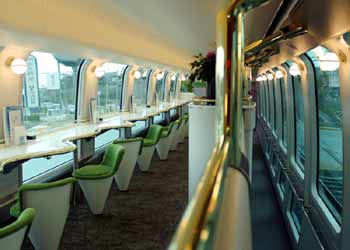 |
||||||
| The lower deck; there are six comfortable armchairs plus a widescreen television (on-train information) on the wall behind the photographer.
Image & license: Asacyan / Wikipedia encyclopædia. CC BY-SA 3.0 http://commons.wikimedia.org/wiki/File:Simakaze_01.JPG |
The elevated cafeteria upper deck which features 13 seats and the not-elevated through-carriage passageway.
Image & license: Oka21000 / Wikipedia encyclopædia. CC BY-SA 4.0 http://commons.wikimedia.org/wiki/File:KINTETSU50000_20141120A.JPG |
||||||
Food and drinks are purchased from a servery counter located at one end of the carriage. The Long Distance InterCity Trains page has a few more photographs showing these trains, including the ability to see out the front / back windows in the two end carriages, the luggage lockers and smoking rooms. More information about this cafeteria carriage and the entire luxurious train can be found at these links: Refreshment TrolleysNot everybody likes walking through the train and queuing to be served at the counter, especially as at busy times the queues can be lengthy, sometimes even extending into the next carriage. Also, some people have difficulty carrying hot food and drinks whilst trying to return to their seats on the gently swaying train - even with the obligatory "carry bags" which prevent burning one's hands when holding hot drinks - so many rail services also provide 'at seat' light refreshment facilities operated by a member of the train crew who walks along the train with a refreshment trolley. Some of the newest trains being introduced into Britain do not even feature refreshment facilities - the train operators suggest that this is to maximise passenger capacity, especially on routes which feed into our bigger cities which nowadays are seen to be "outer-suburban" - so the refreshment trolley will provide the only on-train refreshment service. Knowing that not all rail services offer even refreshment trolleys some passengers will buy refreshments from retail outlets at the station before travelling. |
|||||||
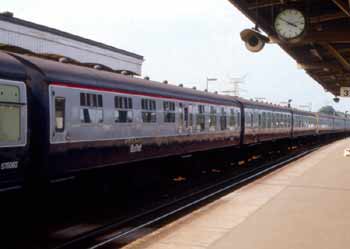 |
 |
||||||
| This train includes a dedicated buffet coach to which passengers would reach by walking through the train. | Nowadays on many trains a member of the train crew wheels a refreshment trolley through the train, offering passengers an 'at seat' service. | ||||||
In the 1950's and early 1960's the former British railways built several fleets of electric multiple unit trains for services between London and the South and East coasts which were designed to offer passengers InterCity-style facilities - including dedicated buffet (or on the East Coast services Griddle) carriages with seats & tables for passengers to consume their food. Although the swift journey times meant that generally lighter refreshments were more appropriate (and not long leisurely meals) the hot kipper breakfast was especially popular. However changing demographics and eating habits plus increased operating costs resulted in the demise of the dedicated buffet carriages long before the rest of the trains - well before railway privatisation... Instead the focus of the refreshments was switched to a member of train crew walking through the train with a refreshment trolley - as seen above right. |
|||||||
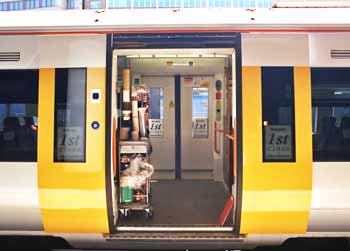 |
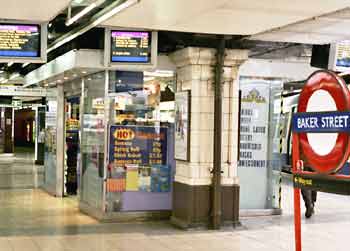 |
||||||
Many types of modern sliding door train do not include food service facilities; so buying refreshments at the station before commencing the journey or from the refreshment
trolley (if provided) are the only options.
By summer 2005 virtually all the older slam-door trains had been replaced with new sliding door trains designed for outer-suburban services on which refreshment facilities (if provided at all) are served from refreshment trolleys. Many passengers also choose to buy their refreshments (especially hot drinks and "snack" type foods) before boarding the trains, usually from sales stalls on the station forecourt / near the ticket hall or on the platforms, as seen above right. This view comes from Baker Street Station on London's Underground where several of the busier stations feature retail outlets selling various types of hot and cold drinks as well as confectionary and snacks. Until WW2 some trains leaving these specific platforms included Pullman carriages which offered cooked meals. Refreshment facilities at stations are looked at on the Stops & Stations page. |
|||||||
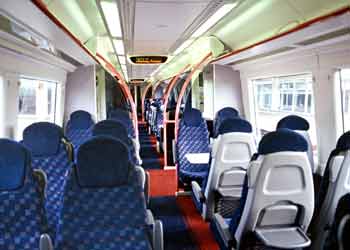 |
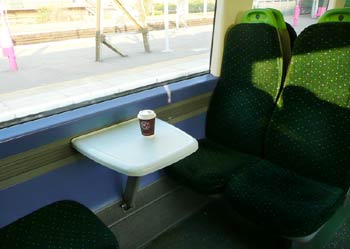 |
||||||
On trains designed for outer suburban and longer distance routes passengers will usually find a range of table options which save them from having to hold their food and drink all the time.
Many trains also include litter bins for discarded food wrappings take-away drink cups (not shown).
A special challenge comes with double-deck trains as there is the not inconsiderable question of getting the trolley up and down the steps between the various levels. |
|||||||
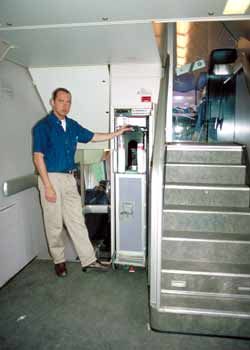 |
 |
||||||
| The clever-clogs Dutch solved this by building a fleet of trains with restaurant - type dumb waiters next to the steps at each end of the carriages and designing their refreshment trolleys to fit inside. This steward very kindly posed for me while at the middle level. |
An alternative option adopted on the Swiss double decker trains seen above is to keep the refreshment trolley on the upper deck and advise passengers when it is passing through the carriage
by illuminating the word "minibar" & arrow symbol located on the lower saloon end-walls. The loudspeaker symbol illuminates when passenger announcements are being made. |
||||||
|
On the busiest of busy routes it can happen that passengers will have the choice of trolley, buffet and full restaurant services, although as stated earlier for full meals some British rail operators insist on giving preference to first class passengers (that is, if they offer full meals at all) often with 'standard' class passengers being refused full meals service. Self Service Vending MachinesBoth loved and loathed, self-service vending machines are well known as a way of selling goods - including light refreshments - on a 24/7 basis without having to have a member of staff available all the time. Their use is well-known at places such as railway station platforms (plus the proverbial 1001 other locations) and some railway operators put them inside the trains too. The example shown here comes from Germany but there are others too. |
|||||||
 |
 |
||||||
| In this train the vending machines are located behind the coffee cup symbol and word "service". This is the intermediate deck of a German double deck train which is used on regional journeys that serve Berlin and its hinterland. |
In addition to the two vending machines (hot drinks and packaged edibles) this photograph shows the "stand up at table" eating area with litterbins underneath and (on the left edge of the image) part of one of the doors to the next
carriage. The opposite side of the carriage (ie: the location from where the photograph was taken) is fitted out with longitudinal seating (without tables), plus - on some trains - a train manager's office. |
||||||
Refreshment Trams |
|||||||
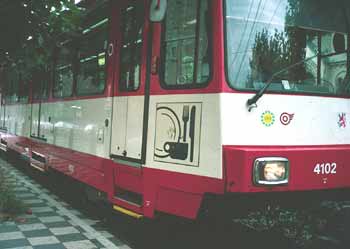 |
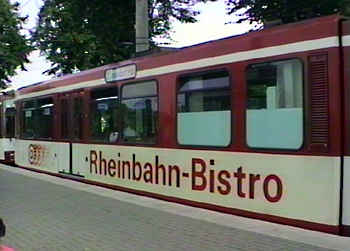 |
||||||
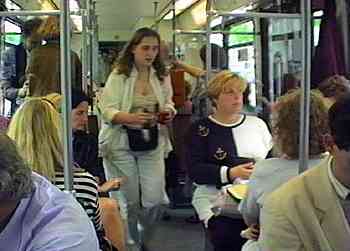 |
Although relatively rare, for many years there were some longer distance light rail services which also offered light refreshment facilities to their passengers.
These views come from the inter-urban line which links Düsseldorf and Krefeld, Germany. Similar vehicles also used to operate on an inter-urban (InterCity?) service which linked Düsseldorf with Duisburg. These services used a dedicated fleet of tramcars which had been modified to include a refreshment preparation area and on which an attendant served passengers at table-equipped seats. |
||||||
|
On very busy heavily loaded routes it can arise that overcrowding becomes an issue which restricts the ability of the railway to carry as many passengers as wish to travel. One solution would be to increase the frequency of the trains, however as much as passengers might like a train every few minutes it can happen that too many trains cause congestion on the tracks - especially at locations where many routes converge. Another solution would be to operate longer trains, however this is not just a simple case of attaching extra carriages to the train! For instance: it is also important that station platforms are long enough for the longer trains, and there may need to be (possibly expensive) alterations to the signalling system (and / or track configurations) as it could impede the smooth operations of the railway if trains which had been lengthened started blocking busy junctions when stopped at a red signal. Where the loading gauge is of sufficient size, the use of double-deck (or bi-level) trains can provide a space (and cost) effective way to carry more passengers, in greater comfort, without the expense of extending platforms, altering signalling systems, etc. To fit both floors within the available loading gauge (so that the train will fit through tunnels, under bridges, a safe distance below overhead power wires, etc.,) some double-decker trains set the bottom deck lower down between the bogies (wheel units), and internally both decks may feature a slightly restricted headroom. British people often ask why double-deck trains do not exist here too. The reasoning is simple - British trains and railway structures are generally of a less generous loading gauge (ie: smaller size - width & height) than overseas railway systems and therefore for most routes to use double deck trains virtually every bridge would need replacing / raising (or the track lowering to pass under it) plus the tunnels would probably need enlarging too. |
|||||||
In 1946 the Southern Railway built two experimental four carriage bi-level trains (which normally operated together as one eight carriage train) for use on suburban services linking London with Kent. However it was not a true double decker as the upper-level seats were squeezed in between the lower-level seats to ensure that its overall height would remain within the clearances necessary to pass through tunnels and under bridges. Restricted clearances also meant that the windows for the upper-level compartments were sealed closed, with forced ventilation being provided instead. The experiment was not deemed to be successful and instead single deck trains were lengthened from eight to ten carriages. Experience found that the upper-levels were somewhat cramped and with the forced ventilation sometimes failing rather stuffy too. In addition, station dwell times were often lengthy - this was attributed to the rather narrow compartment doors which served 22 seats and only permitted one person to pass through at a time. |
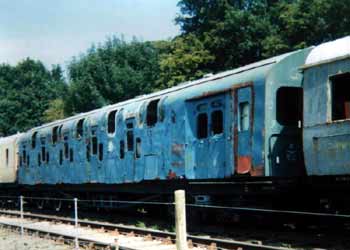
A rather dilapidated looking former Southern Railway double deck carriage which has been preserved at the Northamptonshire Ironstone Railway Trust http://www.nirt.co.uk/ Image & license: Paul Miller / Wikipedia encyclopædia. Free Use with attribution. http://commons.wikimedia.org/wiki/File:Double-decker_BR_coach.jpg |
||||||
Further information about these trains can be found at these links: |
|||||||
 |
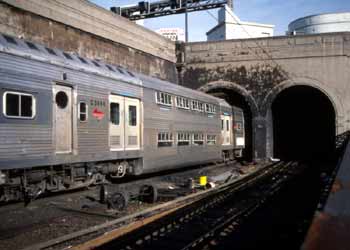 |
||||||
| Comparative view showing how double deck passenger carriages are taller than single deck passenger carriages. Seen in Switzerland. | It is important that all structures - bridges and tunnels - have enough headroom (aka: are large enough) for double deck trains. In Britain many structures would need rebuilding to accept the taller trains. Having crossed the Harbour Bridge a State Rail (New South Wales) train enters Sydney's city centre underground system. |
||||||
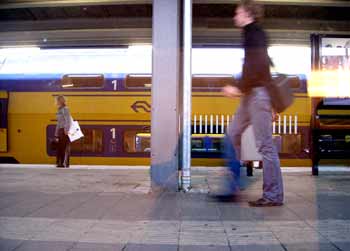 |
 |
||||||
| Comparative views out of a Dutch double-deck trains' windows - lower deck left and upper deck right | |||||||
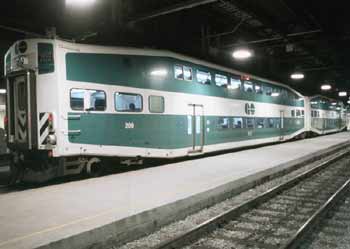 |
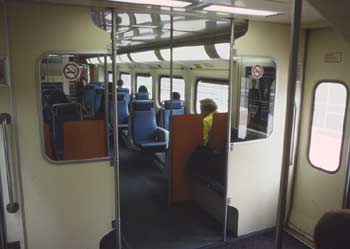 |
||||||
Trains such as these are used on many North American commuter rail systems, sometimes providing peak-hour services only, although on some routes services are more extensive.
The examples seen here are operated under the "GO" label as they were originally funded by the Government of (the Canadian Province of) Ontario. Officially however the transport operator is
known as the Greater Toronto Transit Authority (GTTA), which was established to link Toronto with the surrounding regions of the Greater Toronto Area (GTA).
The image on the left shows a train at Union Station, Toronto. The image also shows how the platforms are barely higher than tracks - in some countries this type of low platform is seen to be an advantageous design feature because it saves commuter rail operators from having to spend scarce funds on building high level platforms; which are often seen to be a costly luxury. Some modern double-deck trains are of the fixed formation "multiple-unit" type where train's motors / engines and control gear are spread out along the train. Another option is to use heavy locomotives to haul the carriages in the traditional way. This has the potential to offer the passengers a better quality travelling experience free from motor / engine noise. For the railway operator it also means that when the passenger carriages are not being used (eg: at night or when undergoing scheduled maintenance, etc) the locomotive can be used for other trains. A third option is to work on the push-pull principle with a locomotive at one end if the train and the carriage at the 'other' end of the train featuring a cab for the train driver. This makes reversing the trains' direction (at termini, etc) much easier as only the train driver must swap from one end of the train to the other end. |
|||||||
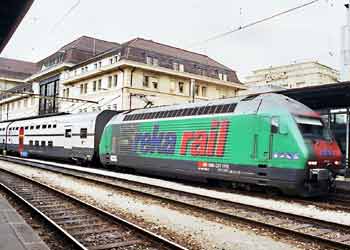 |
 |
||||||
| The Swiss IC2000 double deck trains which work on the push-pull principle with a locomotive at one end if the train and the carriage at the 'other' end of the train featuring a cab for the train driver. | |||||||
 |
 |
||||||
These Zürich, Switzerland double deck suburban trains feature fixed formation units comprising of (three) passenger
carriages plus one dedicated traction unit. Effectively this makes each train unit the equivalent length of a four carriage train. When introduced this surprised
many transport experts because the train units often work in multiple and...
* with a quarter of the train's length being used by the traction units the platforms must be longer than they might otherwise have needed to be to accommodate full length trains, * plus that with multiple unit operation passengers scurrying to passenger carriages on either side of the intermediate traction units will extend the time it takes them to board the train, thereby lengthening "station stop" dwell times. Although marketed as S-Bahn these trains actually provide "Regional Express" services linking smaller towns and cities nearby. As with single deck trains the carriages on double deck trains can either be dedicated solely to passengers of the same ticket "class" - or split between the different classes. |
|||||||
However, with double deckers the possibility exists of splitting the carriage vertically, horizontally, or both! The former would see both decks split between the two classes whilst the middle option would see the different decks being dedicated to the passengers travelling with each of the two ticket types, with (usually) the upper deck being dedicated to passengers travelling 1st class, and the lower deck for those travelling 2nd (or "standard") class. This is the option which is illustrated here. |
 Passengers alight from a German double-deck carriage where 1st class is upstairs and 2nd class is downstairs. |
||||||
The latter option tends to be followed on routes where shorter trains are used (eg: just two passenger carriages) and on commuter routes where fewer passengers travel 1st class. Typically this would mean that just a quarter of the carriage would be dedicated to passengers travelling 1st class. Another variation with double deck trains is how passengers travel from carriage to carriage. There are three options for this; upper level, lower level. or in-between. |
|||||||
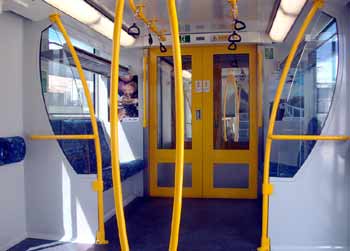 |
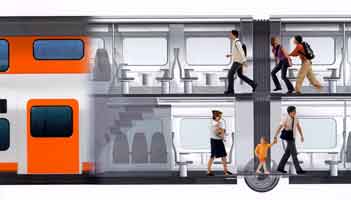 |
||||||
| On Sydney / New South Wales (Australia) double-deck trains the walkway to the next carriage is at the intermediate level. On some carriages this seating area includes space for passengers who use wheelchairs and the corresponding position
in the next carriage has an accessible toilet.
Image & license: Abesty / Wikipedia encyclopædia. CC BY-SA 3.0 http://commons.wikimedia.org/wiki/File:Cityrail_ex_G_Set_vestibule.jpg. |
The Spanish are planning fleet of double deck Talgo trains where passengers on both decks will be able to walk between the carriages.
When built these will be the first trains to feature this. Image: RENFE (Red Nacional de los Ferrocarriles Españoles - Spanish National Railway Network) promotional material. |
||||||
Very High Speed Double-Deck TrainsTo cope with increasing passenger numbers the French and the Japanese have some double-deck TGV (Train à Grand Vitesse - Very High Speed Train) and Shinkansen trains. The French variants are known as TGV Duplex. Each 8 carriage trainset seats 516 passengers - including 184 1st class - this being 40% more than single deck TGV's. As with their single-deck counterparts these trains were also designed to cruise at 300km/h (approx 186mph). To reduce the discomfort from the ear popping sensation when going through tunnels these trains feature airline style pressurised air conditioning. There are two types of double deck Japanese Shinkansen trains, these being the E1 and the E4, both of which are known by the marketing name "MAX" (Multi-Amenity eXpress). At busy times these trains can be as much as 200% loaded (ie: as many passengers standing as sitting). |
|||||||
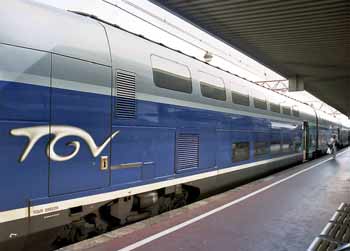 |
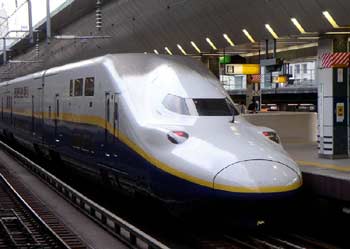 |
||||||
| A French TGV Duplex seen whilst making a station stop, as seen immediately before boarding - and travelling! | Double deck Shinkansen train of the type E4 at Tokyo Tohoku Shinkansen station.
Image & license: %E3%81%A3 / Wikipedia encyclopædia. CC BY-SA 3.0 http://commons.wikimedia.org/wiki/File%3AE4_ series_Shinkansen_train_at_Tokyo_Station_01.jpg. |
||||||
|
The E1 Series Shinkansen were introduced (in 1994) specifically to relieve overcrowding on services used by commuters on the Tohoku Shinkansen and Joetsu Shinkansen, but by 1999 all six trainsets had been transferred to the Joetsu Shinkansen. The E4 Series Shinkansen date from 1997 and were built for commuter service on the Tohoku Shinkansen and Joetsu Shinkansen lines. For extra capacity at busy times two 8 carriage trainsets are coupled together to form 16 carriage trains. Train EntryDepending on the train design and platform height passengers may enter either the carriage at an intermediate level (from where they can go upstairs or downstairs) or at the lower level - from where there will be steps to reach the upper level. |
|||||||
 |
 |
||||||
| On these Zürich, Switzerland double deck suburban trains passengers must climb a few steps to enter the carriage at the intermediate level, from where they can go upstairs or downstairs to seating areas or through to the next carriage. | These Swiss InterCity carriages only have two levels - upper and lower. The entry doors are at the lower level, so only passengers wanting to reach the upper level need negotiate the stairs. | ||||||
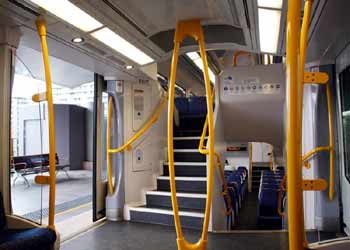
Image & license: brianapa / Wikipedia encyclopædia. CC BY-SA 2.0 http://commons.wikimedia.org/wiki/File:Cityrail_Millennium_Vestibule1.jpg. |
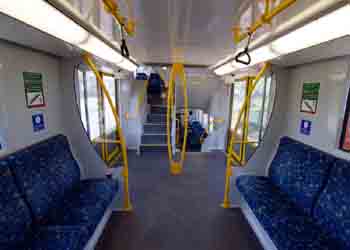
Image & license: Maksym Kozlenko / Wikipedia encyclopædia. CC BY-SA 3.0 http://commons.wikimedia.org/wiki/File:Refurbished_Tangara_train_interior.jpg. |
||||||
| The passenger doors on Sydney / New South Wales (Australia) double-deck trains are located at the intermediate level. Although there is space for some passengers here most of the seating is reached via steps up or down. At some doorways the seats at the intermediate level are of a folding design as this creates extra space for people who use wheelchairs or have young children in pushchairs (buggies, strollers, etc). |
|||||||
 |
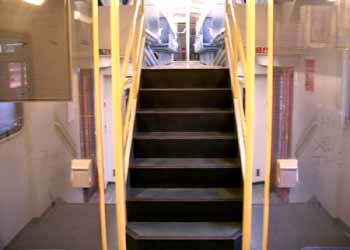 |
||||||
With these (former East) German double deck trains passengers enter at the lower level. The intermediate level (where it is possible to pass through to the next carriage) is reached by using steps located
either side of a central stairway - which links the intermediate and upper levels.
The image on the left also shows some fold up longitudinal seating - this is because the photograph was taken in a carriage where space has been allocated to be available to wheelchairs, pushchairs and bicycles. To make space for them the lower deck is split into three sections with areas of longitudinal seating next to the doorways (next to both of which there is a bicycle symbol on the carriage side) and transverse seating in the centre section. There is a fuller explanation in the Taking Bicycles On Trains. section of this page below. Typically double-deck trains will have only one or two doors (or pairs of doors) per carriage. An exception to this can be found on some of the very busy RER (Réseau Express Régional - in English 'Regional Network, Express') trains which serve Paris, France. The reasoning behind this is to reduce station dwell times on what are exceptionally crowded routes that at the busiest times could be carrying as many as 60,000 passengers an hour, per direction. Whilst externally the trains look virtually identical there are in fact two variants which feature slightly different stair arrangements. The type Z22500 (EOLE) trains are owned by the French mainline railways (SNCF - Société Nationale des Chemins de Fer Français) which uses them on RER line E. On this variant the centre doorway only leads to the lower level seating - apparently the purpose of this arrangement was to create a quieter seating area (on the upper deck) for longer distance regional passengers. The Z2500 (ALTEO) / MI2N trains are owned by the Parisian urban transport operators (RATP - Régie Autonome des Transports Parisiens) which uses them on RER line A - and with this variant all three sets of doors serve both upper and lower level seating. (MI2N means "Materiel d'Interconnexion à 2 Niveaux" - Double Decker Interconnection Equipment / Rolling Stock). These trains operate as "multiple-units" with fixed sets of 5 carriages per train offering 528 seats - and standing space for as many again - if not more! Frequently two such units operate as 10 carriage trains. They include small seating sections for passengers who wish to travel first class. This link http://en.wikipedia.org/wiki/RER will open a Wikipedia page with more information about the Parisian RER. |
|||||||
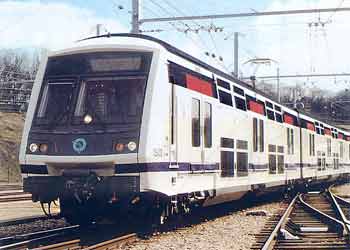 |
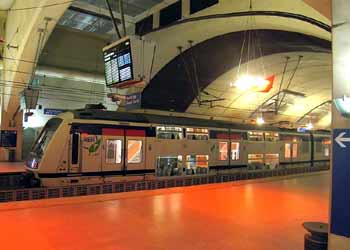 |
||||||
| The triple-door double-deck trains. RATP version above left (& below) and SNCF above right.
The RATP views were sourced from a RATP promotional brochure for these trains. The SNCF view was sourced from the online "Wikipedia" encyclopædia. Image & license: Pline / Wikipedia encyclopædia. CC BY-SA 3.0 http://commons.wikimedia.org/wiki/File:RER-Paris-ligne-E-Rame-Z225.jpg |
|||||||
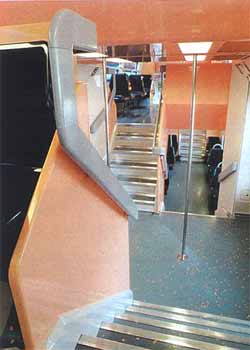 |
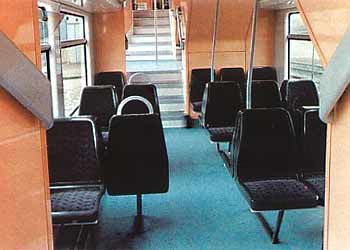 |
||||||
The internal views also demonstrate how the steps alternate from side to side..
Bilevel Gallery CarsWhen double-deck carriages (bilevel cars) were introduced on North American railways (railroads) they identified a problem in that it would be physically difficult - if not impossible - for the conductor to check and sell tickets, collect payment and sell tickets to such a large concentration of passengers in one car, especially in suburban passenger service, owing to the short distance between stops. The solution came in the form of the design of the "gallery" car. These features an upper level in the form of twin mezzanines running along both sides of the car, with an open area between them along the centre - hence the term "gallery". Although it reduced the potential passenger capacity this solution enabled conductor(s) who walk along on the lower level to easily reach up and punch/validate tickets of the passengers seated on the upper level. Passengers would simply place their tickets in clips along a lengthwise panel, located slightly above the conductor's head and within easy reach. The conductor would then quickly check tickets and move to the next car. |
|||||||
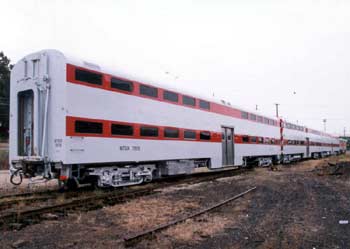 |
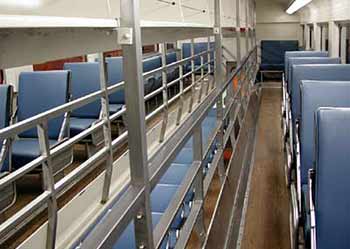 |
||||||
| External and internal views of a North American "Bilevel Gallery Car" showing the gallery and single row of seating on each side of the upper deck. Images courtesy of The Midwest Transportation and Development Corporation who can provide Bi-Level Gallery Commuter Cars to North American transit operators for use on new existing passenger transit operations. More information can be found at their website http://my.ais.net/~dbehr |
|||||||
|
Cyclists often complain that they would like to be able to take their bicycles with them when they travel by train so that having arrived at their destination station they can complete their journey on two wheels. However not all railway (and tramway) operators permit the carrying of large bicycles, although often they will allow the small fold-a-way bicycles to be carried as hand luggage. The issue is that whilst on the train the bicycles have to be located somewhere - and that at busy times this can result in them negatively impacting on other (non-cycling) passengers (blocking seats, taking up space which on busy trains is often already at a premium and possibly even constituting a safety hazard) On services where bicycles are permitted it sometimes happens that bicycle symbols are displayed on the outside of the carriages which have been designed to accommodate them. This is done partly to help the cyclists find where along the (often long) train the bicycle space is located & to encourage them to use it; but it is also done in the hope that in this way the cyclists will leave the rest of the train for passengers travelling without bicycles. As many of the issues related to carrying bicycles on public transport are common to all the transport modes this topic is more fully covered on a small popup page which can be reached by clicking here. |
|||||||
 |
 |
||||||
| On trains which are not equipped with luggage or cycle storage areas the only other option is to block a seating area, which at busy times can be something which inconveniences other passengers. Seen on a British class 142 train (nicknamed as "nodding donkeys".) | In Switzerland many trains feature bicycle hooks in the area between the entrance door and the door to the next carriage. (ie: the section above the wheels). | ||||||
 |
 |
||||||
| When built in the 1950's and 1960's these British trains included a small section dedicated to freight (accessed via the double doors just to the left of the centre of this image - NB: only one of these doors has a window). However more recently there has been very little freight to carry (for instance: the express parcels service has closed) but the space proved to be an invaluable and very popular asset to passengers who wish to travel with their bicycles. It is most unfortunate therefore that (with one exception) when these veteran trains were replaced the train operating companies did not meet the needs of cyclists and instead of providing space for their bikes are banning them - especially at busy times! | |||||||
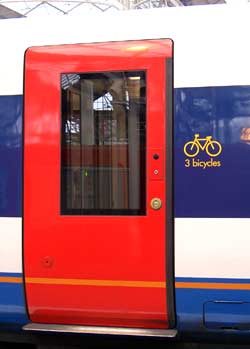 |
 |
||||||
| Possibly the only modern (replacement) rolling stock which does include space for cycles are the Class 444 trains which operate some of the longer distance services out of London Waterloo. But there are only
45 of these trains - and there were several thousand older trains which included luggage space. Each of these 5-carriage trains features two dedicated cycle areas which accommodate three bicycles each. |
|||||||
 |
 |
||||||
| This example was seen in the Austrian city of Salzburg. | This example is the (former East) German double deck train seen under the "Train Entry" heading of the "Double-Deck Trains" section above. | ||||||
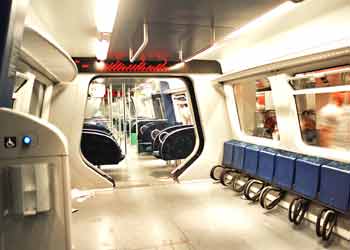 |
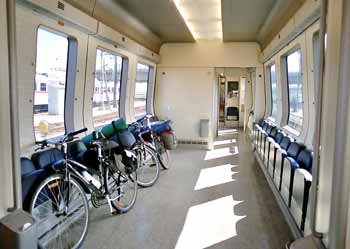 |
||||||
Two views from Scandinavia showing trains equipped with fold-up longitudinal seating as this provides space for bicycles, wheelchairs and young children in pushchairs (buggies, strollers, etc).
The image on the left comes from a S-Bahn (suburban railway) train in the Danish Capital City of Copenhagen. On these trains the special "easy access" space is located in both end carriages of each 8-carriage train, and one side of the carriage is even equipped with front wheel hoops. The image on the right comes from a Danish regional train which also operates across the Øresund link into Sweden. There is just one "easy access" carriage per train, which to make life easier has a low-floor central section. Not seen in this photograph are the self-service vending machines serving very reasonably priced drinks and other light refreshments (confectionary, etc). The Øresund link is a 16 km (10 mile) road & rail link across the Øresund sound linking the Danish capital Copenhagen to the Swedish port of Malmö. Opening in July 2000 it comprises of four sections - a 430metre artificial peninsula at Kastrup on the Danish coast; a 4km underwater tunnel; a 4km artificial island called Peberholm; and on the Swedish side a 7.8km spectacular double-deck suspension bridge with a four lane highway on the upper deck and twin track electric railway below. Included in the link is a new station at Copenhagen Airport. |
|||||||
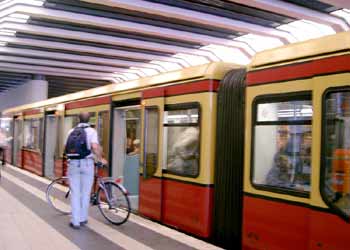 |
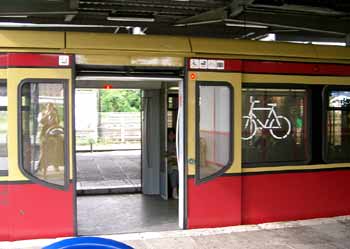 |
||||||
| On the Berlin (Germany) S-Bahn (urban trains) passengers are encouraged to use certain doorways which are marked with a bicycle symbol next to them (as seen in the view on the right). | The red lights seen on the top left corner of the right-hand door and in the doorway of the far doors illuminate (flash) in sync with an audible alarm before the train doors close. | ||||||
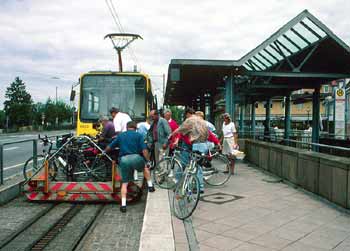 |
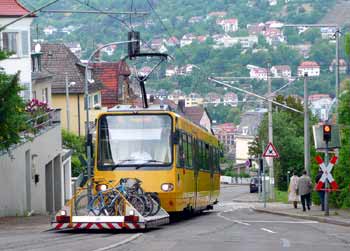 |
||||||
This rack & pinion light rail line in the German city of Stuttgart even includes special flat-bed trailer vehicles just for cyclists!
The view on the left was taken at Degerloch, which is the "lower" terminus, whilst the view on the right was taken where traffic signals protect the trams as they cross a road whilst emerging from a private right of way to a roadside reservation. The bicycle trailer can carry up to 10 bikes and its use is free of charge. However, to avoid possible delays at tram stops whilst the bikes are loaded / unloaded they are only carried on full end - to - end journeys when travelling uphill. Making A Rod For One's Back!One argument used by transport operators for not allowing bicycles anywhere near public transport is that the bike riders themselves do not always act with responsibility. It is also well known that for reasons of personal safety many pedestrians absolutely detest having to share space with people riding bicycles. Unfortunately by their actions some cyclists do create the rod with which their own backs are beaten. |
|||||||
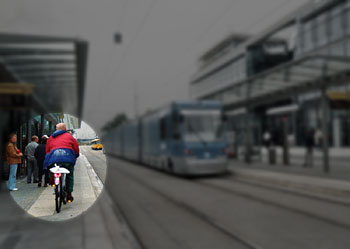 |
 |
||||||
| For safety (of both walking passengers and the rider) bicycles should always be "walked" - and NOT ridden - when on station platforms! | |||||||
Direct links to other Passenger Train Variations pages.
 |
|||||||||||||||||||||||||||||||||||||||||||||||||||||
 |
|||||||||||||||||||||||||||||||||||||||||||||||||||||
 |
|||||||||||||||||||||||||||||||||||||||||||||||||||||
 |
|||||||||||||||||||||||||||||||||||||||||||||||||||||
 |
|||||||||||||||||||||||||||||||||||||||||||||||||||||